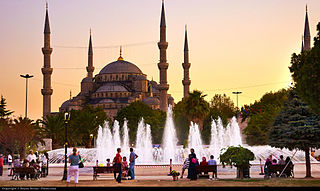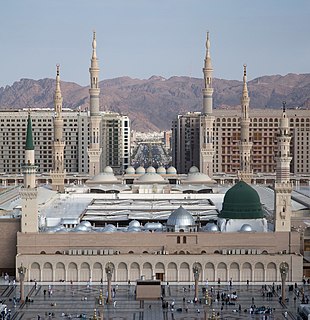
A mosque is a place of worship for Muslims. Any act of worship that follows the Islamic rules of prayer can be said to create a mosque, whether or not it takes place in a special building. Informal and open-air places of worship are called musalla, while mosques used for communal prayer on Fridays are known as jāmiʿ. Mosque buildings typically contain an ornamental niche (mihrab) set into the wall that indicates the direction of Mecca (qiblah), ablution facilities and minarets from which calls to prayer are issued. The pulpit (minbar), from which the Friday (jumu'ah) sermon (khutba) is delivered, was in earlier times characteristic of the central city mosque, but has since become common in smaller mosques. Mosques typically have segregated spaces for men and women. This basic pattern of organization has assumed different forms depending on the region, period and denomination.

Al-Aqsa Mosque, located in the Old City of Jerusalem, is the third holiest site in Islam. The mosque was built on top of the Temple Mount, known as the Al Aqsa Compound or Haram esh-Sharif in Islam. Muslims believe that Muhammad was transported from the Sacred Mosque in Mecca to al-Aqsa during the Night Journey. Islamic tradition holds that Muhammad led prayers towards this site until the 17th month after his migration from Mecca to Medina, when Allāh directed him to turn towards the Kaaba in Mecca.

Sultan Ahmed Mosque is a historic mosque located in Istanbul, Turkey. It remains a functioning mosque, while also attracting large numbers of tourist visitors. It was constructed between 1609 and 1616 during the rule of Ahmed I. Its Külliye contains Ahmed's tomb, a madrasah and a hospice. Hand-painted blue tiles adorn the mosque’s interior walls, and at night the mosque is bathed in blue as lights frame the mosque’s five main domes, six minarets and eight secondary domes. It sits next to the Hagia Sophia, another popular tourist site.

Al-Masjid an-Nabawī is a mosque established and built by the Islamic prophet Muhammad, situated in the city of Medina in the Hejaz region of Saudi Arabia. It was one of the first mosques built by Muhammad, and is now one of the largest mosques in the world. It is the second-holiest site in Islam, after the Great Mosque in Mecca. It is always open, regardless of date or time.
A gram panchayat or village panchayat is the only grassroots-level of panchayati raj formalised local self-governance system in India at the village or small-town level, and has a sarpanch as its elected head.

Tejgaon is a thana of Dhaka District in the Division of Dhaka, Bangladesh. It is in the centre of Dhaka, the capital. In 2006, the boundaries of the thana were redrawn when Tejgaon Industrial Area Thana was created out of the former larger area and again in 2009 when Sher-e-Bangla Nagar Thana was created.
Sipra is a tribe in the Punjab region of Pakistan and India. Sipra is a Muslim, Hindu, Sikh tribe found mainly in the western districts of Punjab in Pakistan.

Nakhalpara is one of the most densely populated small area in the capital city Dhaka of Bangladesh. It is located under Tejgaon Thana & Tejgaon Industrial Area Thana Beside South: Kawran Bazar, farmgate & Tejkunipara, North: Shaheen Bag, Arjat para & Mohakhali, East: Mohakhali Inter City Bus-stand, Nabisco Biscuit Factory & Channel I and West: Old Airport Road, Prime minister's Office.
West Nakhalpara is a densely populated area in Tejgaon.

Shaheenbag is a neighborhood in Tejgaon Dhaka District in the Division of Dhaka, Bangladesh. It is a large area in the centre of Dhaka, the capital of Bangladesh. This is an important area of Dhaka city as prime minister's office is located near it. It is bounded by Mohakhali to the north, Old Airport Road to the west, Tejgaon Industrial Area, Kawran Bazar, West Nakhalpara, Tejturi Bazar and Tejkunipara to the south and BAF Shaheen College, Dhaka Cantonment to the east.

Ahla is a village and Union council of Mandi Bahauddin District in the Punjab province of Pakistan.
Tejkunipara is the name of a neighborhood in Tejgaon Thana of Dhaka city. It is close to the Farmgate neighborhood. Thousands of people live here. All kinds of people live here with different professions.
East Nakhalpara is name of a place at Tejgaon in Dhaka city. Its eastern part is on Nakhalpara. Thousands of people live here. People of all spheres live here.

The Mumbai Regional Congress Committee is the unit of the Indian National Congress for the city of Mumbai. Although Mumbai is part of Maharashtra state, the Mumbai RCC functions as an independent Pradesh Congress Committee unit. The current President of the Mumbai Regional Congress Committee is Eknath Gaikwad

Neopaganism in South Africa is primarily represented by the traditions of Wicca, contemporary Witchcraft, Germanic neopaganism and Neo-Druidism. The movement is related to comparable trends in the United States and Western Europe and is mostly practiced by White South African of urban background; it is to be distinguished from folk healing and mythology in local Bantu culture.

The Great Mosque of Mecca, commonly known as the al-Masjid al-Ḥarām, is a mosque that surrounds the Kaaba in the city of Mecca, in the Hejazi region of Saudi Arabia. It is a site of pilgrimage for the Hajj, which every Muslim must do at least once in their lives if able, and is also the main phase for the ʿUmrah, the lesser pilgrimage that can be undertaken any time of the year. The rites of both pilgrimages include circumambulating the Kaaba within the mosque. The Great Mosque includes other important significant sites, including the Black Stone, the Zamzam Well, Maqam Ibrahim, and the hills of Safa and Marwa.
Ibn Sina mosque, or la mosque Avicenne, is located in Montpellier, France, in the neighborhood of Petit Bard. Situated in the South of France, the Ibn Sina mosque is managed and run by a group of Algerian nationals from the association for the knowledge of Arab culture.
Gurpreet Kaur Sapra is an Indian Administrative Service officer and the District Commissioner of Mohali, Ajitgarh.

Two consecutive terrorist shooting attacks occurred at mosques in Christchurch, New Zealand, during Friday Prayer on 15 March 2019. The attacks began at the Al Noor Mosque in the suburb of Riccarton at 1:40 p.m. and continued at Linwood Islamic Centre at about 1:55 p.m. The gunman live-streamed the first attack on Facebook.
Astyra, also known as Astyrum or Astyron (Ἄστυρον), and perhaps also Andeira (Ἀνδειρα), was a small town of ancient Aeolis and of Mysia, in the Plain of Thebe, between Antandrus and Adramyttium. It had a temple of Artemis, of which the Antandrii had the superintendence. Artemis had hence the name of Astyrene or Astirene. There was a lake Sapra near Astyra, which communicated with the sea. Pausanias, from his own observations, describes a spring of black water at Astyra; the water was hot. But he places Astyra in the territory of Atarneus. There was, then, either a place in Atarneus called Astyra, with warm springs, or Pausanias has made some mistake; for there is no doubt about the position of the Astyra of Strabo and Pomponius Mela. Astyra was a deserted place, according to Pliny's authorities; he calls it Astyre. There are said to be coins of Astyra.












